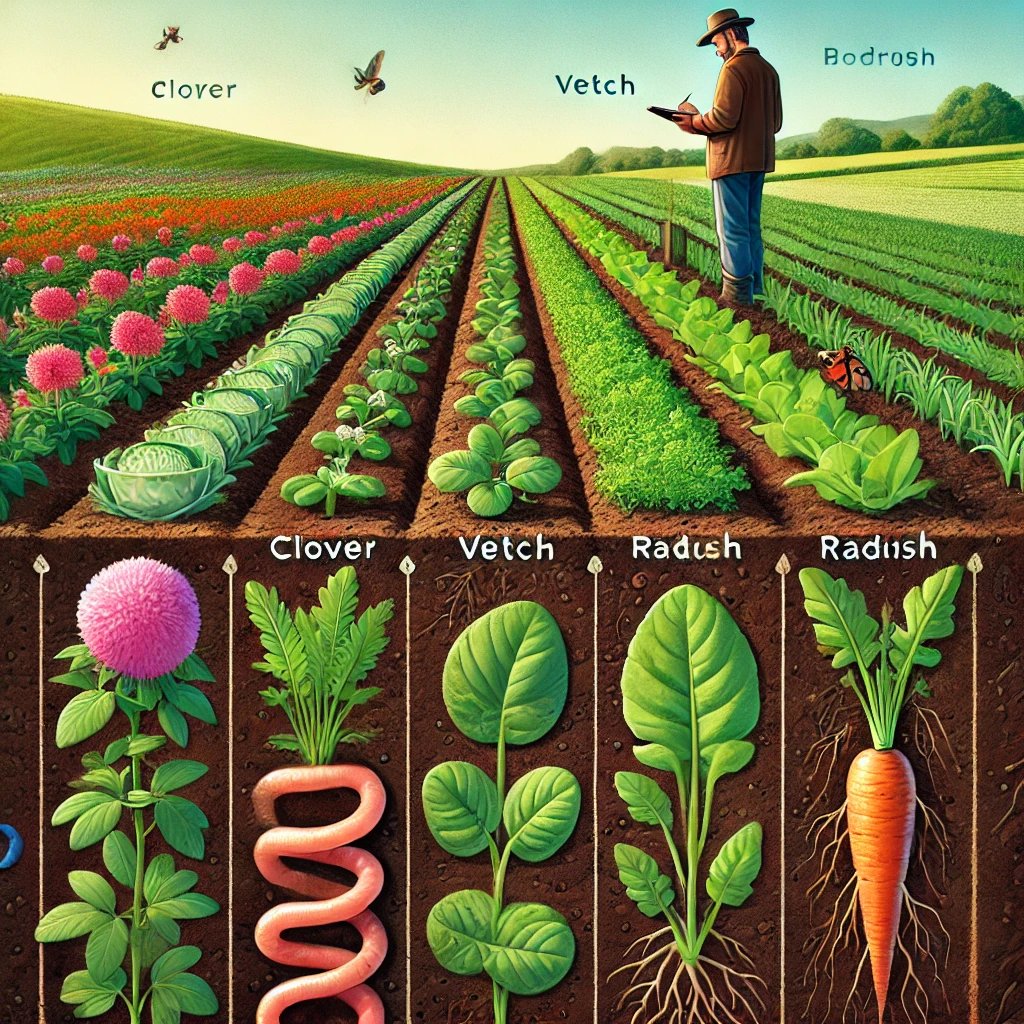Benefits for Soil and Your Bottom Line
As a farmer, you know that your soil is your most valuable asset. Healthy soil means healthy crops, and healthy crops translate to a healthy bottom line. But conventional farming practices can take a toll on soil health, leading to erosion, nutrient depletion, and increased reliance on expensive inputs. Cover cropping offers a powerful solution.
By planting non-cash crops specifically to benefit the soil, you can improve soil structure, suppress weeds, reduce erosion, and even boost the yields of your subsequent cash crops.
This article will guide you through the key strategies for successfully integrating cover crops into your field crop production system.
1. Choosing the Right Cover Crop Mix:
Selecting the right cover crop species or mix is crucial for maximizing benefits. Consider your primary goals: Are you looking to fix nitrogen, suppress weeds, break up compaction, or all of the above?
Your choice will also depend on your following cash crop, your soil type, and your local climate. Here’s a breakdown of some common cover crop categories:
- Legumes (Nitrogen Fixation): Legumes, such as clovers (crimson, red, white), vetches (hairy vetch), peas (Austrian winter peas), and beans (fava beans), have a symbiotic relationship with nitrogen-fixing bacteria in their root nodules. They can capture atmospheric nitrogen and convert it into a form usable by plants, reducing your need for synthetic nitrogen fertilizer.
- Example: Hairy vetch planted before corn can provide a significant portion of the corn’s nitrogen needs.
- Grasses (Soil Structure, Erosion Control, Weed Suppression): Grasses, like cereal rye, oats, annual ryegrass, and barley, have extensive root systems that improve soil structure, prevent erosion, and scavenge excess nutrients. Cereal rye, in particular, is known for its allelopathic properties, meaning it releases chemicals that inhibit weed germination.
- Example: Cereal rye planted after soybean harvest can protect the soil over winter and suppress weeds in the spring.
- Brassicas (Compaction Relief, Nutrient Scavenging): Brassicas, such as oilseed radish (daikon radish), turnips, and mustards, have deep taproots that can break up compacted soil layers and scavenge nutrients from deep in the soil profile. They are also known for their biofumigant properties, which can help suppress soilborne pests and diseases.
- Example: Oilseed radish planted after wheat harvest can alleviate compaction and improve drainage.
- Mixes: Combining different cover crop species can provide multiple benefits. For example, a mix of a legume and a grass can provide both nitrogen fixation and erosion control.

2. Establishing and Managing Cover Crops:
Successful cover crop establishment is key to realizing their benefits. Consider these factors:
- Seeding Rates: Follow recommended seeding rates for your chosen species or mix. Seeding rates will vary depending on the species, planting method, and desired outcome. Your local Extension office or seed supplier can provide specific recommendations.
- Planting Methods:
- Drilling: Drilling provides the most precise seed placement and ensures good seed-to-soil contact, leading to better germination and establishment.
- Broadcasting: Broadcasting is faster and less expensive than drilling, but it may result in lower germination rates, especially in dry conditions. If broadcasting, consider increasing the seeding rate and incorporating the seed with light tillage or a cultipacker.
- Aerial Seeding: For large acreages, aerial seeding can be a cost-effective option, especially for seeding into standing crops.
- Timing: The optimal planting time depends on your climate, your following cash crop, and the cover crop species. In general, fall planting is common for winter cover crops, while spring planting is used for summer cover crops.
- Termination: Terminating the cover crop at the right time is crucial to prevent it from competing with your cash crop. Common termination methods include:
- Roller-Crimping: A roller-crimper is a specialized implement that crimps the cover crop stems, creating a mulch layer that suppresses weeds and conserves moisture. This is a popular method in no-till systems.
- Mowing: Mowing can be effective for terminating cover crops, but it may require multiple passes to prevent regrowth.
- Herbicide Application: Herbicides can be used to terminate cover crops, but choose herbicides carefully to avoid carryover effects on your cash crop. Consider using non-selective herbicides like glyphosate only when necessary and with appropriate precautions.
- Winter Kill: Some cover crop species, like oats and oilseed radish, will naturally winter-kill in cold climates, eliminating the need for mechanical or chemical termination.
3. Nutrient Cycling and Nitrogen Fixation:
Cover crops play a vital role in nutrient cycling. They can:
- Scavenge Nutrients: Deep-rooted cover crops can take up nutrients from lower soil layers that might otherwise be lost through leaching. These nutrients are then released back into the topsoil when the cover crop decomposes.
- Fix Nitrogen (Legumes): Leguminous cover crops, as mentioned earlier, can fix atmospheric nitrogen, reducing the need for synthetic nitrogen fertilizer. The amount of nitrogen fixed varies depending on the species, growing conditions, and the amount of biomass produced.
- Improve Nutrient Availability: The decomposition of cover crop biomass adds organic matter to the soil, which improves soil structure, water-holding capacity, and nutrient availability.
4. Weed Suppression with Cover Crops:
Cover crops can be a powerful tool for weed management, reducing herbicide use and its associated costs. They suppress weeds through several mechanisms:
- Competition: A dense stand of cover crops can outcompete weeds for light, water, and nutrients.
- Allelopathy: Some cover crops, like cereal rye, release chemicals that inhibit weed germination and growth.
- Physical Smothering: A thick layer of cover crop residue can physically prevent weed seeds from germinating.
5. Integrating Cover Crops into Different Cropping Systems:
Cover crops can be incorporated into a wide range of cropping systems. Here are a few examples:
- Corn-Soybean Rotation: Cereal rye planted after soybean harvest can provide winter cover, suppress weeds, and scavenge excess nitrogen. A legume cover crop, such as hairy vetch, can be planted before corn to provide nitrogen.
- Wheat-Fallow: Oilseed radish or a mix of brassicas can be planted after wheat harvest to break up compaction, scavenge nutrients, and suppress weeds during the fallow period.
- Vegetable Production: Cover crops can be used between vegetable crops to improve soil health, suppress weeds, and manage pests and diseases.
Conclusion:
Cover cropping is a versatile and powerful tool for improving soil health, enhancing crop production, and increasing farm profitability. By carefully selecting cover crop species, managing them effectively, and integrating them into your cropping system, you can reap the numerous benefits they offer. Start experimenting with cover crops on a small scale, learn what works best for your farm, and gradually expand their use to maximize their positive impact on your soil and your bottom line. Don’t be afraid to consult with your local Extension agent or a certified crop advisor for personalized recommendations.
References:
- SARE (Sustainable Agriculture Research & Education). “Managing Cover Crops Profitably, 3rd Edition. https://www.sare.org/publications/managing-cover-crops-profitably
- Clark, A. (Ed.). (2007). Managing cover crops profitably (3rd ed.). Sustainable Agriculture Network.
- Magdoff, F., & Van Es, H. (2009). Building soils for better crops: Sustainable soil management. SARE.
- Hartwig, N. L., & Ammon, H. U. (2002). Cover crops and living mulches. Weed Science, 50(6), 688-699.
- Reeves, D. W. (1994). Cover crops and rotations. Crops and Soil Environmental News.
- Tonitto, C., David, M. B., & Drinkwater, L. E. (2006). Replacing bare fallows with cover crops in fertilizer-intensive cropping systems: A meta-analysis of crop yield and N dynamics. Agriculture, Ecosystems & Environment, 112(1), 58-72.
- Thorup-Kristensen, K., Magid, J., & Jensen, L. S. (2003). Catch crops and green manures as biological tools in nitrogen management in temperate zones. Advances in agronomy, 79, 227-302.
- Teasdale, J. R. (1996). Contribution of cover crops to weed management in sustainable agricultural systems. Journal of production agriculture, 9(4), 475-479.
- Creamer, N. G., Bennett, M. A., Stanyard, B. K., & Wiebold, W. J. (1996). A method for determining the presence and concentration of allelochemicals in soil. Journal of Chemical Ecology, 22(9), 1769-1779.
If you want to learn more about Cover Cropping Practices, check out Agri AI : Smart Farming Advisor and feel free to ask any questions!

Leave a Reply